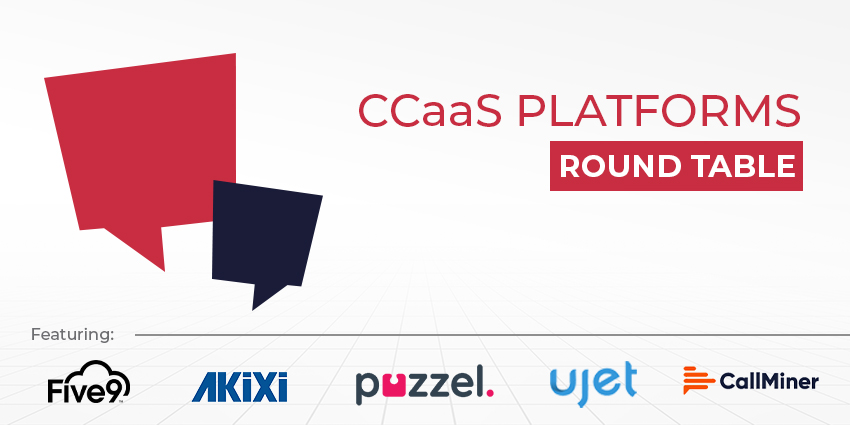Contact Centre as a Service (CCaaS) is a software deployment model that enables companies to reduce IT, integration and support costs. It’s needless to say that transforming a contact centre is a mammoth task by itself, moving it to the cloud requires double the time and effort. Investing in a good CCaaS not only impacts business agility and digital transformation but also improves customer experience in the long run.
In this edition of the CX Today round table, we welcome:
- Genefa Murphy, Chief Marketing Officer, Five9
- Jonathan Allan, Chief Marketing Officer, Puzzel
- Paul Holden, Head of Sales, Akixi
- Colin Gill, Head of Production and Solutions, Akixi
- Baker Johnson, VP of Marketing, UJET
- Frank Sherlock, VP International, CallMiner
Experts from five companies share their thoughts on how cloud contact centres have transformed to benefit CX, ways to future-proof a business with CCaaS and what the companies prioritised during the pandemic.
Here’s what they had to say.
How has the evolution of cloud contact centres benefitted CX?
Murphy: “With the pandemic, the contact center was thrust into the spotlight for most businesses. The contact center essentially became the new front door. The evolution of cloud technology, and the increased acceptance by consumers to use digital channels, has enabled organizations to reimagine CX by increasing business agility, accelerating digital transformation and embracing continuous innovation.

Businesses that migrate their contact centers to the cloud can quickly and cost-effectively take advantage of the latest technologies to streamline operations with automation and analytics, empower their agents to work from anywhere, engage customers on their channel of choice, and use the power of AI to scale their workforce with Intelligent Virtual Agents (IVAs).
“Leveraging the cloud’s flexibility, scalability and ease of integration, these innovations are creating better experiences for both customers and agents through their facilitation of an agile mindset that enables customers to rapidly respond to changes in the market.”
Allan: “Pre-covid, the contact centre was just one part of the full customer experience. It was where customers went to solve problems, and almost always came before or after a face-to-face or in-store interaction. Now with video, virtual agents, CRM integrations and real-time reporting, the contact centre has transformed, for many companies, into the face of their brand. It is fast becoming a hi-tech, multi-functional business unit capable of delivering immersive end-to-end customer experiences with AI-powered precision and a human touch, making the moments that matter happen.”

Holden: “Cloud contact centres have benefited the customer experience as they have enabled companies to offer a consistent service, 24/7, from any location, across multiple platforms. The traditional method of making a call to a business and being restricted to certain hours of availability, governed by resource in that location, would dictate how long you were held in a queue.
Utilising the cloud, the hours and resources can be far more flexible, agents can be in any location, even at home, all on the same platform. The other advantage of the evolution of cloud contact centres is also the ability to introduce digital and social channels into the customer experience, offering further choice and flexibility of interaction by the end customer to enhance the experience.
“Building on this cloud foundation, introduction of digital and social, also opens the door to integration with other cloud applications that hold customer intelligence, for example the CRM or ERP system, so you’re empowering your representatives with information which also enables great CX, as an end customer they get through on their channel of choice, voice or digital, and get a more personalised experience which ultimately will build brand advocacy and loyalty.”
Johnson: “Easier, more flexible integrations with CRMs and other external systems – we are particularly passionate about this at UJET! The ability to quickly display customer information is key, but to us it doesn’t stop there. Part of the power of the cloud is that it is easier to pull information from many sources and have it displayed. Many of our customers connect UJET to their mobile apps and can see customer information from the app, ask customers to take photographs of problems, send them instructions to the phone, and make switches from chat to voice effortless and the context is retained.”
“Next, the cloud has helped contact centers add non-voice communication channels easily. We see contact centers of all sizes branch out to digital channels when they move to the cloud. Customers have the ability to seek contact in a channel they prefer, and the ability for agents to use one interface to work with customers in voice, chat, email, SMS, or other channel is a strength of the cloud.”
Sherlock: “Cloud-based contact centres contain a plethora of data that can dramatically impact customer experience and customer relationships overall. The contact centre is the frontline of an organisation’s business – it’s the place where customers go to communicate with your brand and more often than not, find resolution to issues they may be having. It’s where the voice of the employee, voice of the customer and the overall brand perception are conveyed – whether that’s over the phone or in text-based interactions.”
But today’s customers are communicating across more channels than ever before. Cloud contact centres make it possible to more effectively and flexibly scale as business needs change.
“This flexibility is a key part of being able to not only collect and monitor those interactions, but analyse and extract insights from every conversation. When organisations deeply understand their customers, they can make better decisions in-the-moment and post-interaction to drive CX.”
“Cloud contact centres make it easier to keep pace with changing customer expectations, based on deep understandings and insights.”
How can CCaaS help future-proof a business?
Murphy: “A cloud contact center allows for both iterative and incremental adoption of new technologies as well as rapid innovation. With cloud, organisations can evolve as fast as the market, which promises a competitive advantage when customer expectations change on a dime.
“For example, during the pandemic it has become increasingly important to support more efficient self-service options, such as online help, intelligent virtual assistant (IVA), as well as digital channels like social media, webchat, and text/SMS. Being able to adapt quickly – and continuously – helps enterprises future-proof their CX. And, given better CX has been proven to have a correlation to loyalty, it in turn future proofs the business.”
Allan: “CCaaS solutions are designed to be easy and fast to deploy, and to grow with your business. Most importantly, the ability for these cloud solutions to support constant innovation and improvement means that customer systems are always moving forward and making the most of new features, integrations and technology developments.
With customer behaviours and expectations changing all the time, it no longer makes sense to buy an expensive to deploy on-prem solution that will become outdated as soon as it’s installed. Businesses are better off buying a cloud solution that is continually updated with the latest tech, that can scale with their business, and that can be customised with apps and integrations at any time to suit their unique needs.”
Holden: “Contact-Centre-as-a-Service can help future-proof a business as the

CCaaS vendor takes ownership of keeping the technology current and up to date whilst the end user business consumes the service on a subscription basis. In the legacy world, you had to make a significant capex investment in technology and within 18 months it was already one or two versions out of date. You had to adapt your business processes around the technology, it was inflexible, coupled with the fact that you would have to replicate the same capex at multiple sites, especially in the enterprise space.
“CCaaaS and the move to cloud reduces the capex or one-off expenditure to mainly project set-up costs, then you subscribe and consume the service, which means everyone and every site takes advantage of the same technology. This gives flexibility of resourcing, hours of availability, software updates can be automatic, and you can adapt the technology to best practice business processes due to its flexibility. The technology becomes an enabler to scale the business and to openly integrate with your other systems, bringing information to your representatives to enhance the CX.”
Johnson: “If this past year has taught us anything, it’s that being adaptable is critical. HUGE changes in how our customers interact with us and how we do business can happen in a matter of days.

CCaaS has some specific advantages that assist with change.
- The ability to scale up and down, even unplanned changes, can be accommodated.
- Adding new channels is swift and provides a consistent agent experience.
- Companies often change through mergers and acquisitions – adding new sites is easy. Training is standardized, reporting is unified, and queues can be configured to work for, not against the business.
- Meeting privacy laws and requirements is increasingly strenuous across the globe. At UJET, we see that CCaaS can help with compliance – if architected properly, no personally identifiable information is stored in the system. We see this as essential, because the future will bring more regulation in personal data privacy.
- When there are updates to software, CCaaS automatically adds those enhancements to your company’s capabilities. No need to go through a painful, difficult software update. If the CCaaS platform is designed well, these updates will happen without interruption in service. You will always have the “latest and greatest” at your contact center’s fingertips!
Sherlock: “Contact Centre as a Service technology is a great solution for either smaller organisations, organisations who need to stay agile, or even those that don’t have the resources (or desire) to run and manage their own contact centres.

Because CCaaS solutions essentially leave the operation of the contact centre to a vendor, it makes it easier for organisations to increase or decrease capacity as needed, project and plan for more consistent costs, and eliminate the need to hire dedicated maintenance or operation staff.
“Certainly, CCaaS isn’t right for every business, but for those where it’s a fit, it’s a great option to get the benefits of a contact centre, without the overhead cost or upkeep.”
How has the pandemic impacted your product roadmap?
Murphy: “The pandemic was a reason to accelerate certain aspects of our product roadmap based on customer demand. For example, the increased preference toward a digital-first experience is reflected in an increase in digital interactions on our platform (up 80% year-over-year in the first quarter of 2021). Key areas included product enhancements to support additional engagement channels and the release of a new digital first pricing bundle that allows customers to get started with IVAs in the cloud even if they aren’t ready to move everything to the cloud (Five9 IVAs can connect to on-prem telephony). The traction we have in digital is particularly important as we expand internationally, especially in parts of the world where digital channels like WhatsApp are the channel of choice.
“We also accelerated our plans in practical AI and Automation. At the end of 2020 we acquired Inference Solutions, an industry leader in conversational AI. This combined with the organic investments we had already made (Five9 Agent Assist) allow us to provide customers with a continuum of AI & Automation solutions pre, during and post interaction. These technologies help customers scale quickly and effectively and we have seen a surge in interest and adoption amongst our customer base.”
Allan: “The pandemic has accelerated the need for video in the contact centre. In a socially distant world, video has become a vital channel for connecting with family, friends and colleagues. Now as more customers move online and businesses embrace hybrid working, it has become a vital channel for customer service as well.
“Puzzel is working to integrate video and co-browsing into its CCaaS solution, enabling contact centre agents to video chat with customers and share their screens to solve problems faster.”

Gill: “Our product roadmap hasn’t significantly changed as a result of the pandemic. The ability for our workforce to quickly and easily shift to home working meant that our usual development processes, along with all Akixi’s business functions, were able to continue at the usual pace.
“However, over the past few months many of our partners and customers have been using Akixi’s business analytics software to monitor and manage their own internal teams, whereas previously its application was more focused on customer interactions. This is undoubtedly a reflection of the shift to remote working, and it has given managers and team leaders the ability to effectively monitor and manage their team members even though they are no longer sitting together in the office. With this in mind, we have adjusted the scheduling and prioritisation of certain product updates, bringing features such as Akixi’s new Personal Dashboard to the top of the product development schedule.”
Johnson: “The pandemic has put considerable pressure on contact centers as interaction volumes have reached all-time highs. At the same time, agents have had to simultaneously navigate new work environments, new tools, new services, and global supply chain issues. This has forced us as a CCaaS provider to prioritise roadmap initiatives that aim to augment the customer journey by making self-service capabilities more accessible and across multiple touchpoints. Also, with the growing pressure on agents, we’ve had to prioritise new tools and workflows that reduce both friction throughout the customer journey and effort for the agent so they can solve the problem faster. The goal is not only greater efficiency for the agent and the customer, but increasing the degree of personalization and offering an improved experience for both parties.”
Sherlock: “The pandemic has certainly made many things more difficult – from isolation and burnout to understanding and adapting to changing customer demands and expectations.
But for the most part, has had very little impact on our product roadmap. We’ve been able to continue to develop and deliver products that are meeting the needs of customers across a wide range of segments and industries. We’ve been able to focus on improving our products and go-to-market strategy, as well as integrating our work in AI and ML into our roadmap. The pandemic hasn’t stopped our ability to innovate.
“Beyond product roadmap, at the onset of the pandemic, CallMiner launched the Coronavirus Customer Think Tank, which made it easier for organisations to analyse interactions, uncover what was important to customers and employees, and respond quickly and effectively. Our goal was to help brands overcome the unexpected challenges of the pandemic and work together to share best practices, experiences and insights.”







